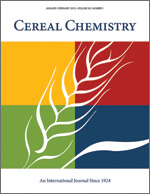
Cereal Chem 57:380 - 382. | VIEW
ARTICLE
Reaction of 14C-Cysteine with Wheat Flour Water Solubles Under Ultraviolet Light.
J. S. Sidhu, R. C. Hoseney, J. Faubion, and P. Nordin. Copyright 1980 by the American Association of Cereal Chemists, Inc.
Cysteine and glutathione reacted with 14C-fumaric acid when exposed to ultraviolet (UV) irradiation. The UV irradiation presumably initiated a free radical on the sulfhydryl group, which then added to the activated double bond of fumaric acid. Ferulic acid and trans-cinnamic acid, both of which contain activated double bonds, affected dough mixing tolerance in a manner similar to that of fumaric acid. UV irradiation of wheat flour water solubles, in the presence of 14C-cysteine, followed by fractionation of the water-soluble fraction on Sepharose 4B showed that most of the bound radioactivity was eluted at the void volume of the column. This result was expected for cysteine reacting with ferulic acid esterified to the water-soluble arabinoxylan. This finding suggests that ferulic acid is an indigenous activated double bond compound that affects mixing tolerance and also provides a mechanism by which pentosans are covalently bound to proteins during dough mixing.